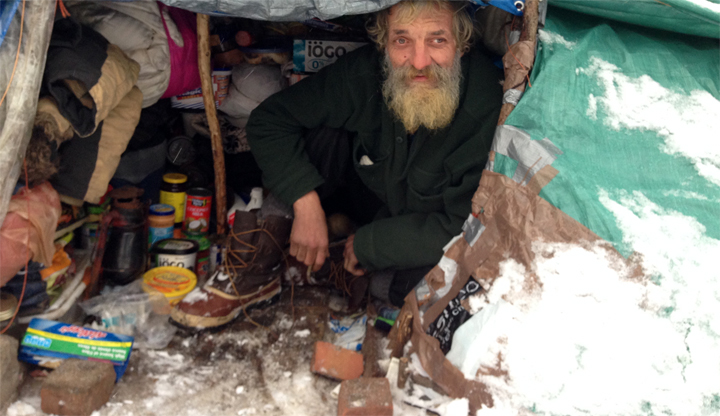The place Stephen Brausewetter has called home for almost three years is a cramped, ramshackle tent, hidden in a gully surrounded by trees, just out of sight of comfortable middle class homes in Scarborough.

Brausewetter was happy to show it to a Global News crew when we arrived in the company of outreach workers from Agincourt Community Services.
“It’s the greatest little place on earth,” he said, crawling inside to the makeshift bed he had created at one end of the tent. Foodstuffs were stacked at the other. He insisted it was comfortable.
Brausewetter said he previously worked for a renovator and had a room until March of 2012, but he was fuzzy on the details as to why he had become homeless. He has a long, straggly beard with streaks of grey, his fingers were stained brown. He said he was 54 years old.
He said his brother and sister gave him money from time to time, allowing him to buy what food he had.
I asked him whether his loved ones worried about him and whether they advised him to find shelter.
“I already went out that, avenue to get a place…there’s no rooms available,” he said.
Jennifer Hartley, an outreach worker with Agincourt Community Services, told us after our meeting with Brausewetter that they have known him for some time and check in on him regularly.
“We’re just continuously engaging with him, trying to encourage him to seek housing and allow us to help him access services,” she said.
Agincourt Community Services invited us to ride along with their outreach workers after seeing the Global News story on the funeral of Grant “Gunner” Faulkner, a homeless man who was found dead in the charred remains of a shed that he had been using as a makeshift shelter. They all knew him and felt his loss, but they also wanted our audience to know that there are people trying to help the homeless and that sometimes they do score small victories by convincing someone to accept their assistance and get out of the cold.
WATCH: (Jan. 26) Hundreds of mourners attend funeral of homeless man who died in a makeshift shelter
They warned us in advance that we might not actually meet any homeless people, or that those we might meet might not want to speak. Mental health problems are common. But they were anxious to show us the places where homeless live and how outreach work differs in Scarborough from the downtown core.
We met them at their Sheppard East headquarters and piled aboard the van they use to patrol a huge area of the city: from Steeles Avenue south to the lake, from Morningside Drive in the east to York University to the west.
Homelessness is not just a downtown problem, manifested by people sleeping on sidewalks. In the outer reaches of the city it is also pervasive, but often less visible. Shelters are fewer and the distances between them greater, with poorer transit service—a challenge both for the homeless and the people trying to help them.
“We have a map of the drop-ins in the downtown and they’re close together. We only have a handful in Scarborough,” said Glen Gifford, the manager of the Agincourt Community Services outreach program.
The first stop on our tour was barely two blocks away from his office: an abandoned cube van parked behind a vacant former bank.
Hartley and her co-worker Michelle Oosterhof asked us to hang back while they investigated, knocking on the door of the van to announce themselves. It was empty, but someone had been there recently, with a mattress and comforter in the back.
“Somewhere to keep warm and out of the cold. And no one will bug them here, behind an abandoned building,” said Hartley.
“Our homeless population is very resourceful; they’ll check the back of trucks (to see if they’re unlocked).”
Next was a wooded area behind some industrial buildings, adjacent to railroad tracks. We agreed to not reveal the exact locations of the encampments that they were showing us. A tent was barely visible above the snow. A bicycle and chair sat beside, partially buried. The site was abandoned. The outreach workers told us that the man who had been living there continually refused their help and now they had no idea where he was.
For most of the year, with leaves on the trees, the encampment would be virtually invisible. It is common for homeless to hide their living arrangements in this way, partly to protect against the theft of their few belongings, partly to withdraw from society.
Stephen Brausewetter’s tent is not far from where I live. I have driven by his spot countless times, with no idea that a homeless man had been camped there. I asked him how he kept warm in sub zero temperatures.
He crawled into his home and emerged with a can.
“This is a cheap way of keeping warm: putting a candle in a can.”
A small open flame inside a cramped tent is inherently dangerous, but the outreach workers said all they can do is encourage him to be careful.
“We can’t change them. They have to want the change themselves,” said Michelle Oosterhof.
“It’s very much just being there when they want that change.”
- What is a halal mortgage? How interest-free home financing works in Canada
- Capital gains changes are ‘really fair,’ Freeland says, as doctors cry foul
- Ontario doctors offer solutions to help address shortage of family physicians
- Budget 2024 failed to spark ‘political reboot’ for Liberals, polling suggests




Comments